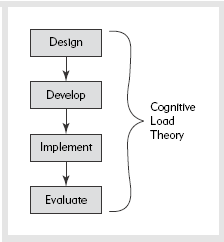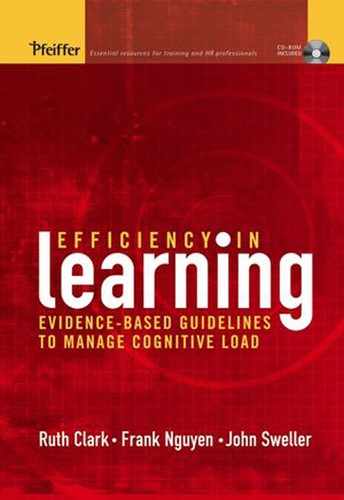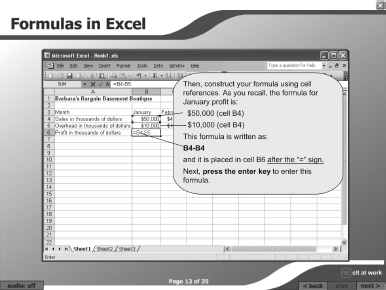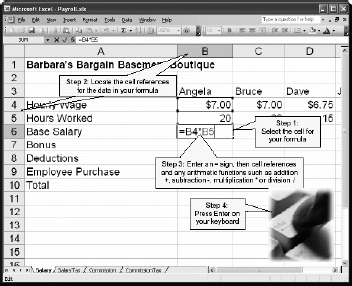
Throughout the book we have summarized guidelines and supporting evidence for managing cognitive load in your instructional programs. In Part II we looked at ways to use instructional strategies to reduce extraneous load imposed on working memory and to manage intrinsic cognitive load resulting from your content complexity. In Part III, we summarized ways you should exploit available working memory capacity to help learners build relevant schemas with techniques that impose germane load. In Part IV we discussed the adjustments you need to make based on the expertise of your learners.
In this summary chapter, we synthesize the guidelines presented previously to help you transfer our recommendations into your instructional activities. This chapter is relevant to readers who are responsible for training design and development or facilitation of classroom or synchronous e-learning, as well as for individuals who are reviewing off-the-shelf courseware.
When you first receive your instructional assignment, take some time to evaluate these three factors: the relevant background of your target audience; the complexity of your content; and the media mix that will be used to deliver your training. To minimize split attention while reading this chapter, we recommend that you print a copy of Table 12.1, which is on the accompanying CD. We will illustrate our commentary on the three factors using our Excel demonstration courses shown on the CD.
We have seen in Part IV of this book that instructional methods that are effective for novice learners don't help—and sometimes even hinder experienced learners. So one important first step will be to research and define the backgrounds of the intended learners. Sometimes, such as when you are teaching a completely new computer application, everyone will be new to the content. In other situations, such as when you are teaching an advanced skill, just about everyone will have some relevant experience. Often however, your audience includes a mixture of novice and experienced learners.
Table 12.1. Applying Cognitive Load Theory to Your Training.
When your learners are novice, they won't have schemas relevant to the new knowledge and skills they need to acquire. Therefore, you will need to provide schema-substitutes as a support until learners have more of a psychological basis for standing on their own. These supports are all of the methods we described in Part II for reducing extraneous cognitive load. However, if your learners are more experienced or will become more experienced in a lengthy training program, then you should abandon most of these methods. With more experience, your audience has relevant schema and the instructional supports that aid novices will in fact slow down experienced learners. Refer to specific guidelines in Table 12.1 for methods appropriate for experienced learners.
If you have a mixture of low and high experience learners, you have several alternatives for tailoring the training to individual needs, depending on your delivery media and organizational resources. If you are delivering via asynchronous e-learning, you can use pretests and adaptive diagnostic tests to guide learners to introductory and more advanced sections of the course. If you are delivering in the classroom, you can assign prework to help equilibrate prior knowledge before class starts. Alternatively, you can establish and enforce prerequisites. Along with prerequisites, you can organize courses into introductory and advanced sections and in that way arrange for a more homogeneous group of participants.
In our analysis of our Excel audience (financial analysts), we found a great deal of variation in learner background and work requirements. Some learners were experienced with Excel use for some basic functions but had diverse needs for specialized calculations and charts based on new work assignments. Other learners were completely new to Excel. Beyond a need for the basic functions of Excel, the requirement for different Excel applications varied based on the analysts' work assignments. Therefore, we have a very heterogeneous audience regarding incoming skills and desired outcomes.
Over the next three years the total population of analysts needing some Excel training will likely approximate one thousand. Many of the analysts who use Excel are highly paid and would prefer to invest time in acquiring only skills directly relevant to their work needs. The analysts work individually so that group collaboration opportunities available in face-to-face instruction were not a major satisfier or need. In response to these factors, an asynchronous e-learning program offered the best delivery option.
As you define the content and instructional objectives, consider content complexity, whether the objectives require near or far transfer learning, and whether computer application training is involved. We have solid cognitive load guidelines for these three content factors.
For high complexity content, your learners will experience high intrinsic cognitive load. You can artificially reduce this load using the methods described in Chapter 5 and summarized in Table 12.1. The main strategy is to segment the content in ways that supporting knowledge is trained first, followed by major lesson content such as process stages or task steps. Keep in mind that content complexity is not the same as content difficulty. In cognitive load theory content complexity is a function of the number of elements that must be processed in working memory simultaneously. See Chapter 1 to review the differences between content complexity and difficulty.
In some training, the learning objectives are primarily near transfer. That is, workers should apply new skills in a consistent way to a consistent environment. Many procedural tasks such as logging onto email or completing a customer order form are examples. The main challenge to achieving near transfer training success is to duplicate the work environment as closely as possible during the training. For example, if learning to use a new system, provide practice on the same system or a close simulation of it.
In other cases your learning objectives will require far transfer performance. In far transfer, learners must build relevant schemas that must later adapt to a variety of different work contexts. Effective sales and coaching skills are two common examples. In far transfer training you will need to provide learners with diverse examples and scenarios. Because the diversity adds cognitive load, it will be very important to use worked and completion examples, as discussed in Chapter 9. In addition, far transfer almost invariably imposes a heavy cognitive load because learners must use working memory resources to work out how learned material applies to a new situation. That cognitive load can be reduced if the learned material is automated, as discussed in Chapter 9. Therefore, if far transfer is the goal, make sure the material is very well learned.
Finally, a great many organizational training resources are directed toward teaching use of new technology. When training use of computer systems, embed all of the instruction in the computer in order to avoid split attention. If learners are reading steps in a manual and trying to apply them to an application screen on the computer, split attention results, as discussed in Chapter 4. Likewise, duplicating all of the computer screens and explanations in a manual that requires the use of the computer as well leads to redundancy, as discussed in Chapter 5. Your best bet is to get rid of the manual and incorporate all training onto the computer.
We judged most of the content in our Excel lesson as moderate to high complexity, in that learners will need to devote memory capacity to several perceptual, physical, and cognitive factors involved in identifying relevant screen components, defining the mathematical goal, translating the goal into proper formula formats, and using the mouse and keyboard to implement the procedure.
The Excel course is designed to support analysts who will need to produce various reports and displays to help decision makers evaluate data. It will be important that learners see how Excel procedures can be operationalized for diverse purposes and with diverse data sets. In other words, the outcomes are far transfer. Therefore, we included a variety of Excel scenarios as the basis for worked examples and practice exercises.
Of course, Excel is a computer application. To minimize split attention and redundancy, we integrated all of the training onto the computer.
An important feature of delivery media relevant to cognitive load theory is the degree to which learners control the pace at which they are exposed to instruction. In a classroom—physical or virtual—the instructor controls the pace and learners must keep up. In contrast, in print or some forms of asynchronous e-learning, learners can control the rate at which they progress through training. They can usually reread and revisit various segments of the instruction as needed. Therefore, delivery media that permit learner control of pacing tend to impose much less cognitive load.
If your delivery media will be instructionally paced, then it's especially important that you apply as many of the guidelines as are practical to minimize extraneous and intrinsic cognitive load.
Your delivery media, of course, will also affect how you implement other methods for managing cognitive load. Obviously, in print media you do not have the advantage of audio narration, and therefore you must concentrate on minimizing split attention by placing text close to the information to which it refers, using pointers to reduce the need to search for referents. In asynchronous e-learning you have capabilities to assess learner progress and tailor instruction to differences in their expertise through adaptive testing, as described in Chapter 11.
Cognitive load theory applies to all media. Regardless of media, all lessons designed for novices that teach tasks or procedures should include worked examples, practice exercises, and relevant visuals to display main content. Likewise, all instruction should minimize divided attention, although it may do so in different ways. All instruction should also minimize extraneous cognitive load imposed by unneeded themes, vignettes, audio, technical information, or flabby writing.
For our Excel demonstration course, a number of factors pointed to asynchronous e-learning as the major delivery medium. The learning audience is quite large and globally located. Likewise, the organization is most interested in maximizing efficiency in instruction of highly paid analysts by tailoring it to individual skill backgrounds and work requirements.
However, design and development of asynchronous courseware tends to take longer than virtual classroom versions. This is because the asynchronous courseware must include all relevant feedback to exercises as well as audio narration, both of which are handled by the instructor in the virtual classroom version. In addition, the asynchronous version must be programmed. Since there is an immediate need for training, a virtual classroom training adapted from a classroom course will serve as an intermediate solution. The virtual class will be delivered first, followed by an asynchronous e-learning version to follow at a later date. You can see both the virtual classroom and asynchronous e-lesson samples on our CD.
We exploited the capabilities of the asynchronous e-learning by including rapid diagnostic tests that will assign learners to relevant topics in the course and that will diagnose their learning progress and assign the optimal mix of completion examples and practice based on their level of expertise. Although dynamic assessment is not practical in the virtual classroom version, we did use a pretest (not shown in the example) to assign learners to the appropriate virtual sessions.
In both the e-learning versions, we had the opportunity to use audio to explain relevant visuals. However, in the case of completion examples and practice, audio is too transient and case data and directions are placed in text on the screen. Where text is used, it is placed close by relevant visuals with pointers to avoid split attention. Furthermore, although the default version in the asynchronous lesson is audio, learners can revert to text alone by turning off the audio controls. Both courses use a series of worked and completion examples ending in full practice.
In this section of the chapter, we discuss some tips for developing your training materials in accordance with cognitive load theory.
Since many of the cognitive load guidelines at the development phase relate to treatment of visuals, we recommend defining the major visuals to be included in the program as an early step. In addition, since many organizational training programs do not allow sufficient time to practice many skills, we recommend planning your performance aids as another early step. In that way, you can build your instruction around the performance aids and the visuals.
As we described in Chapter 3, appropriate visuals can greatly promote learning and increase engagement in the instructional materials. Conversely, inappropriate visuals can add extraneous cognitive load. Examine the major tasks associated with each lesson to define the dominant visuals associated with those tasks as well as ways to most effectively create a performance aid.
In our Excel lesson on formulas, a spreadsheet Excel screen capture was the natural predominant visual interface. For more details on appropriate visuals to use for different instructional outcomes, refer to Chapter 3 and to Clark and Lyons (2004).
As you define your visuals and performance aids, consider whether they will need explanations or whether they can be designed to be self-explanatory, similar to the airline emergency procedure visuals that use arrows to communicate motion. Remember that to add words to a self-explanatory visual results in redundancy that slows learning. In most cases, you will need to explain your visuals and performance aids, and we recommend using audio narration to do so in order to leverage the modality effect.
As you draft the visuals and performance aids, you can also write the scripts to be used by instructors or by narrators in asynchronous e-learning. The format and wording of the script will vary depending on your delivery medium. For example, a classroom instructor with subject-matter expertise might need only bulleted text points to prompt her explanations. On the other hand, a professional narrator will need detailed scripts when creating audio for asynchronous e-learning. Regardless of media, make every word in your scripts count. The result should be just enough words to communicate the content, as discussed in Chapter 5.
If you are using asynchronous e-learning delivery, you may not have software or hardware to deliver audio narration. Even if you are using audio narration, you may also need to provide a text option for a subset of learners lacking audio delivery capabilities or who have hearing loss. You will then need to write descriptions in lean text and place them close to the visual being explained. In addition, there are some places in the lesson where you should not use audio because it is too transient and learners need an opportunity to review the words over a period of time. For example, all directions for exercises or completion examples should be delivered in text only. Likewise, any data needed for case studies and feedback to exercises should remain visible for the learner to review.
As you are working out the visuals, performance aids, and scripts to teach the major tasks, plan a series of worked examples and practice exercises. In general, we recommend starting with a fully worked example that is explained with instructor or audio narration. Next present faded worked examples in which the learners are required to fill in one or more steps. For the faded worked examples, present all words in on-screen text. End the sequence with a full practice exercise presented in text. If learners will need to apply the skills to different scenarios later, on the job, be sure to incorporate different surface features into your examples and practice exercises, as discussed in Chapter 9. For example, when practicing constructing formulas in Excel, we provide examples and exercises that use profit, payroll, and sales projections. The different scenarios add germane cognitive load that is offset by using faded worked example progressions, as described in Chapters 8 and 9.
Many tasks will have associated supporting knowledge, such as processes and concepts. The supporting knowledge should be sequenced in the lesson either before or after the major lesson task to manage the amount of new content presented to learners all at once. For example, the task of constructing a formula in Excel requires supporting knowledge of what is a valid format for an Excel formula. In the virtual classroom lesson, this concept was taught prior to the worked examples of how to input a formula in a spreadsheet. To make the lesson more interactive, the instructor displayed several examples of formulas and asked the learners to define some of the features associated with formulas. Learners input their responses using the chat facility. Using frequent questions that require learners to study examples and form conclusions is important to maintain a high level of interactivity in e-learning environments.
As you implement our research findings and guidelines, you will find that software packages that are currently used to create asynchronous courses—such as web development tools and even specialized courseware authoring tools—do not support cognitive load guidelines by default. Even worse, some cannot be configured to support principles to manage cognitive load at all. In general, most courseware authoring programs currently available on the market violate the redundancy principle, do not always provide appropriate visual cues to direct attention, and do not support diagnostic testing.
Training on how to perform procedures in software is quite commonly delivered as asynchronous e-learning. Software simulations are the most common method used for instruction and practice in such courses. Tools used to develop these simulations are quite robust, often offering lesson-user interactions, data tracking, and even audio. However, the vast majority of software simulation packages violate the redundancy principles by providing a visual of a software screen explained by on-screen text and audio narration. As a result, the student may experience cognitive overload with the redundant text and audio in the presence of a complex visual.
To implement methods such as those used in our Excel asynchronous e-lesson demonstration, such software simulation tools should ideally offer facilities to explain software screen visuals with audio narration by default. In addition, in the event that the student does not have audio capabilities on her computer or the language in the course may not be her native language, the software simulation should provide the student with the ability to turn off the audio. With the sophistication of current learning management systems (LMS) and courseware, the course could even be launched with audio on or off, depending on the student's personal preference configured in the LMS.
In the event that the user turns off audio narration in his course and opts to read on-screen text instead, cognitive load theory suggests that the course developer should integrate the text with appropriate locations on the courseware's screen to minimize split attention. As shown in Figure 12.1, we used red lines to connect on-screen text to the corresponding location in the spreadsheet. While most courseware development applications do provide various tools to draw the student's attention to different locations on the screen, visual cues are often limited to bold lines or circles, on-screen arrows, or even animated lines that can lead to split attention.
Implementation of diagnostic assessment for adaptive e-learning is generally not supported by authoring software. In our Excel demonstration we begin with a rapid assessment in order to assign learners to just the topics they need. Unfortunately, some practice and assessment software packages on the market do not provide this dynamic, prescriptive ability. Therefore, extensive technical coding ability is required to program it. In addition, judging of learner responses to questions and assessments is very inflexible. For instance, if the correct answer to a question is The Sky Is Blue, and the student enters the sky is blue or simply blue, the assessment software may judge the answer as incorrect unless it is explicitly told to ignore the case of the text and is also programmed with all the possible answers that the student may answer. Although the recent research on rapid assessment has used open-ended responses to math problems, we suggest that multiple-choice items may be a more practical format, given the constraints of the software packages.
These limitations in authoring software present some difficulties in implementing cognitive load principles to your asynchronous courseware today. In time, however, the effort and cost to incorporate these guidelines in your content should decrease as vendors who provide software to create courseware incorporate the facilities to readily create training that reduces extraneous cognitive load.
Implementation involves the deployment of courseware to the learners. For instructor-led courses, implementation requires training and supporting instructors to deliver the instruction in the most efficient manner. Implementation of asynchronous e-learning from a cognitive load perspective requires ensuring that learners have structured opportunities and distraction-free environments for learning.
Since the use of visuals, text, and audio are fundamental to learning efficiency, the instructor plays a major role in applying cognitive load theory in classroom or synchronous e-learning environments. We recommend that all instructors be trained in basic cognitive load theory principles so they understand how to best utilize the limited capabilities of learners' working memory during training.
For example, instructors should provide succinct explanations of visuals displayed on slides. For content displayed in text, instructors should display slides and pause while learners read them. Instructors should avoid redundancy caused by reading onscreen text—especially when there is a visual on the slide.
Instructors provide germane load through explanations of worked examples, by asking learners to complete examples, and by calling on one or more participants for their answers. They can also promote self-explanations of worked examples by asking learners to list the principles or rules illustrated by various aspects of the example and by calling on one or more participants to give their explanations. Instructors are also responsible for gaining and sustaining attention during learning. They do so by eliminating distractions of extraneous events, stories, and audio during explanations, and by frequent questions and other interactive assignments relevant to the instructional goal.
In many situations learners complete asynchronous training at their work stations using their production computers during breaks or lulls in their normal work routine. Depending on the work environment, this arrangement can reduce efficiency due to (1) production platforms that do not support audio; (2) distractions and interruptions in the work setting; and (3) over-reliance on workers to initiate and complete training in an environment of conflicting priorities. If any of this sounds familiar, consider an investment in regional learning centers that are located in a separate area from the work environment and that include platforms that support efficient courseware.
Managers should work closely with their workers regarding expectations and progress in training no matter what the delivery mode. However, manager support in asynchronous learning environments is especially important to ensure that learners are engaged in courseware that is appropriate to their background and assignments and are making progress in learning and applying new skills.
As you plan your instructional handouts, you need to consider the risks of redundancy. It's common practice to hand out a copy of the slides used in an instructional presentation on which learners take notes. This may not be an efficient approach for two reasons. First, the visuals are a redundant expression of what learners are seeing in projected slides. Second, taking notes during an instructional presentation becomes a divided attention task.
However, learners will need working aids to apply new skills on the job after training. To best apply cognitive load theory, we recommend that handouts be provided after the instructional presentation. This frees working memory to focus solely on learning from the instruction. Following the lesson, reference materials should be provided. For example, in our synchronous Excel lesson, note that exercise directions and memory support are included on the instructional screens, as illustrated in Figure 12.2. Learners do not need to refer to any additional materials during the lesson. For later use, a reference document is provided that includes the definitions and examples of formulas and the steps to enter a formula. For task reference support, we recommend a visual of the interface with embedded steps, like the one in Figure 12.3.
You may be more interested in evaluation of courseware than in the processes involved in producing it. Before beginning any evaluation, you will need to consider the three factors we summarized in Figure 12.1. Begin with a planning process (also called a training needs assessment) to (1) define the audience background experience; (2) classify the type and complexity of the content involved; and (3) determine the most efficient mix of delivery media. Table 12.1 summarizes guidelines to consider for each of these three criteria. You can create an expanded list of quality assurance factors by building on each of these guidelines. To make them more useful, you can illustrate each guideline with relevant examples and non-examples from your own training. Such a list can serve as an evaluation vehicle when reviewing off-the-shelf or custom-developed software, as well as a quality guide for internal developers.
In this chapter we have integrated the many guidelines discussed throughout our book into a context relevant to instructional professionals. Overall you will need to apply appropriate guidelines based on:
The background knowledge of your target audience
The complexity, transfer requirements, and computer involvement of your content
The mix of delivery media used in the training
Chapter 12: Applying Cognitive Load Theory. John discusses applications of cognitive load theory
The asynchronous Load Managed Excel Web Based Learning and the synchronous Virtual Classroom Example both illustrate most of the principles discussed in this chapter.
The Overloaded Excel Web-Based Lesson violates most of the guidelines pertaining to extraneous cognitive load. You can see a critique of this lesson by selecting Listen to Dr. John Sweller's Commentary.
In this chapter we integrated many of our guidelines into a context in which instructional professionals will apply them. In the next and final chapter, written by John Sweller, you have the opportunity to review the principles and research behind cognitive load theory from his personal account of how it started and has evolved over the past twenty-five years.



